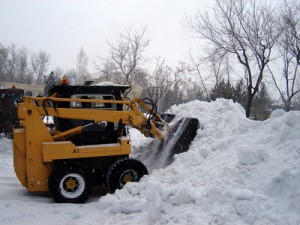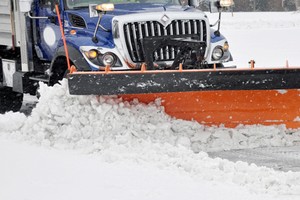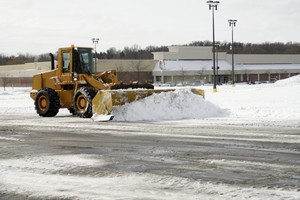
Winter weather conditions can quickly make driving dangerous. However, most people must still go to work, school, and run other errands despite the snow and ice, so municipalities have to send out Chicago snow plows to clear the roadways. When Chicago snow plows are out on the roads, it is important to drive slowly and carefully so that you can avoid accidents with the Chicago snow plow itself as well as other vehicles.
Be On The Watch Out For Chicago Snow Plows On The Road
First, these large machines typically travel about 35 miles per hour or less as they scrape the streets. It can be tempting to pass the slow-moving, bulky machines, but this is dangerous. Remember, the road ahead of the Chicago snow plow is not yet clear of its snow and ice. Also, snow plow drivers have a limited range of vision due to the shape of their vehicles, and their blades can stir up swirling snow clouds that make it even more difficult to see. They may be unable to see you as you pass.
Additionally, some snow blades can extend eight feet beyond the edge of the car, and you may not be able to see these blades to pass around them safely. Lastly, if you cannot avoid passing, remember that Chicago snow plows push the snow to the right side of the road, so you typically want to pass to the left. Also, when you cut back in front of the Chicago snow plow, remember that the blade sticks out several feet beyond the front of the truck.
Give Chicago Snow Plows Plenty Of Room On The Road
Lastly, if you are passing a Chicago snow plow that is coming from the other direction, try to move over as far as you can. This is because wide blades can edge into your lane, making you more likely to clip your car on the plow.
With winter on its way, it is important to understand how to drive safely in inclement weather. However, not everyone may take the time or have the patience to drive slowly and carefully in hazardous road conditions. This can put you and your loved ones at risk of terrible accidents.
 4 Types of snow removal tools you should know. Chicago snow removal is the process of removing snow from sidewalks, driveways, roads and parking lots by the use of specific tools. Listed below are some basic tools for removing snow
4 Types of snow removal tools you should know. Chicago snow removal is the process of removing snow from sidewalks, driveways, roads and parking lots by the use of specific tools. Listed below are some basic tools for removing snow
1. Snow shovel
- Wide blade with no sides
- Designed to push snow, not lift
- Blade can be metal or plastic
2. Snow Blower or Snow Thrower
- Comes in either one- or two-stages
- Electric, gasoline or diesel
- Manually operated or attached to a vehicle
- Comes in a variety of sizes
3. Ice Pick
- Used to break up ice by pick or chipping
- Similar to a scratch awl
4. Snow Plow
- Mounted to a vehicle
- Comes in steel or plastic
Snow removal tools come in a lot of different forms, but all do the same thing, remove snow from one location to another. Depending on where you live you will use one or more of these tools. Of course the larger the area you need the clear the bigger the tool you will need. Snow fall can come in many forms from the light puffy stuff to the wet packed snow, to a bit of both light and wet snow. Use caution whether in a vehicle or by hand. Use proper safety steps and know what is underneath before you start snow removal. Snow removal is done by cities, contractors and individuals. It is a labor intensive activity. Calling your Chicago snow removal professionals is the best way to ensure it is done right.
 The most widely accepted commercial tool for snow removal is the snow plow. This is especially useful in large capacities. In modern times, a snow plow consists of a large pick-up truck with a large plow that is permanently attached. Some plows will an electric and/or hydraulics used to raise and lower them. Even bigger plows may be affixed to a very large tractor, backhoe or loader. Some of which may contain more then one large plow and even distribute salt as they plow. Aside from pickup trucks, snow plows can also be found on other types of vehicles such as a personal SUV or even a small riding mower that is traditionally used to cut grass in the summer. Snow plows are also used to mount on rail cars to remove snow from train tracks.
The most widely accepted commercial tool for snow removal is the snow plow. This is especially useful in large capacities. In modern times, a snow plow consists of a large pick-up truck with a large plow that is permanently attached. Some plows will an electric and/or hydraulics used to raise and lower them. Even bigger plows may be affixed to a very large tractor, backhoe or loader. Some of which may contain more then one large plow and even distribute salt as they plow. Aside from pickup trucks, snow plows can also be found on other types of vehicles such as a personal SUV or even a small riding mower that is traditionally used to cut grass in the summer. Snow plows are also used to mount on rail cars to remove snow from train tracks.
Where snow blowers work by use of an impeller to draw snow into the chute a snow plow works different and uses a much simpler concept. Using the force of the vehicle the snow plow is pushed either forward or on an angle. The blade of the snow plow captures the snow and forces it towards the direction of the vehicle clearing the surface previously covered.
The earliest versions of a snow plow were powered by horses. The wedge-type blades were made of wood. Since the invention of the automobile the snow plow was logically adopted and converted for use with vehicles. Patents for snow plows were issued as far back as the early 1920’s. The first infamous plow for vehicles was created by two brothers named Hans and Even Overaasen from Norway. They constructed a plow for use on vehicles which was soon paved the way for traditional equipment used today to clear roads, railways and airports. Soon after the Overaasen Snow Removal Systems came into being. Another milestone inventor by the name of Carl Frink was also considered an early manufacturer car-mounted snow plows. His company, Frink Snowplows, which was based out of Clayton, New York, was created in 1920 and still runs today under the name Frink-America.
Trains and snow plowing go back as far as the mid-1800’s. An interesting invention known as the rotary snow plow was created by a Canadian dentist named J.W. Elliot. A rotary snow plow contains a set of blades positioned in a circle. It works by rotating the blades and cutting through the snow as the train moves forward. The rotary snow plow was conceived after ongoing problems with the traditional wedge plow. The wedge snow plow, which works like many plows today, simply could not move the snow aside quick enough for trains. The rotary snow plow requires the power of an engine to rotate the blades. Usually, a second engine is used to assist in moving the train while the first one in front is responsible for removing the snow. As the blades turn the snow is lifted through a channel and forced to the top out the chute. The operator sits up top in a cab behind the chute he or she has the ability to control the direction of the chute and rate of speed of the blades. These controls eventually led back to the ‘pushing’ engine so that the operator of a pushing locomotive could have control. In areas where severe snowfall is called for the use of ‘double’ or ‘duel’ rotary engines were put into use. The engines would contain rotary plows on both ends. They were often effective in clearing snow from rail stations and in situations where the snow continued to accumulate after going in one direction.
The earliest rotary blades were power by stem engines while newer ones are powered by gas or electricity. Due to the advancement of newer technologies rotary blades are seldom used anymore. They are also very expensive to maintain an only used as a last resort by many railway companies.
Plows were a godsend to citizens in the late 1800’s. It helped ease the stresses of transportation. While horse-drawn plow was uncommon in most cities in North America in the 1860’s – it soon became widespread with popularity. However with the clearing of roadways came a new problem that we still see today. While plowing effectively cleared roadways it blocked the sidewalks and side roads that pedestrians used to travel on. Piles of snow lined the sides of streets. Citizens complained and even brought about lawsuits targeting plowing companies. Store owners complained that their store fronts were inaccessible to customers because of the mounds of snow left behind as a result of plowing. Pedestrians had to overcome the snow while walking down sidewalks. Sleigh riders also became annoyed as the resulting plowed surface created ruts and uneven surfaces.
The citizens of major cities across North America responded in several ways. They hired people to shovel the walkways and horse-drawn carts to remove the snow. Often, they worked in conjunction with the plow companies to haul the snow away into nearby rivers. This not only resolved the issues for pedestrians and store owners but also created a small surplus of jobs for the winter season. This can still be seen today.


